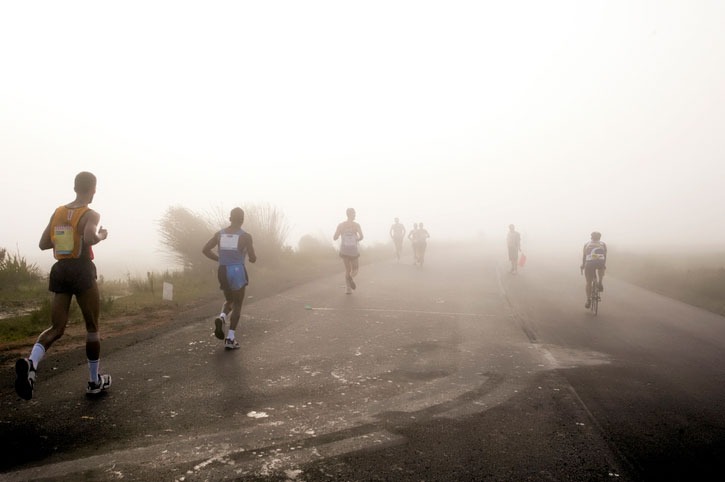Humans are certainly not the fastest runners on the planet. But what we comparatively lack in speed, we make up in endurance, determination, and perseverance. As our ancestors foraged for food, hunted wild game, and evaded ferocious predators, they evolved to run for seemingly impossible durations and distances in the name of survival.
The following bachelors and Master’s programs offer career-focused instruction delivered by trained nutritionists with experience in the field. Find out more what each individual course of study offers through the locations below.
Concordia University St. Paul offers an MS in Strength and Conditioning. Begin or advance your health and fitness career with an exercise science degree from Concordia University, St. Paul.
When farms and markets made it possible to survive without braving the wilderness, however, we began using our running abilities for pure sport. Over two thousand years ago, the Greeks held the first Olympic games that centered on a specific endurance sport: marathon running. Since then, marathons have only become more popular for athletes, appealing to professionals and amateurs alike.
But as Professor Denise Howard, Chair of Concordia University, St. Paul’s online Exercise Science and Sport Management Bachelor Programs, said in an interview with NutritionEd.org:
“Running a marathon isn’t hard enough for some. Now we run farther.”
And not just a little farther, either. In the aptly-named sport of ultrarunning, athletes push their bodies to extreme limits, running for hours and hours at a time – often without stopping. Some even run these distances in environments deemed too harsh to live in.
But what exactly is ultrarunning? How does an athlete even get into an extreme sport like this?
Here, we unpack how today’s nutrition and health science experts actively prepare runners for what could be the hardest races they’ll ever encounter.
 NutritionED.org was able to learn more about ultrarunning from Denise Howard, Assistant Professor and online Exercise Science and Sport Management Bachelor Program Chair at Concordia University, St. Paul (CSP). With the bulk of her professional experience coming from her roles as group fitness instructor, personal trainer, development coach, running coach, training center coordinator, and corporate wellness speaker, she now primarily teaches courses on exercise science and sport management at CSP. Her research focuses on extreme endurance, the intersection of nutrition and performance, and the effects of cardiovascular disease. She is currently on track to complete her EdD in Kinesiology from CSP in 2024.
NutritionED.org was able to learn more about ultrarunning from Denise Howard, Assistant Professor and online Exercise Science and Sport Management Bachelor Program Chair at Concordia University, St. Paul (CSP). With the bulk of her professional experience coming from her roles as group fitness instructor, personal trainer, development coach, running coach, training center coordinator, and corporate wellness speaker, she now primarily teaches courses on exercise science and sport management at CSP. Her research focuses on extreme endurance, the intersection of nutrition and performance, and the effects of cardiovascular disease. She is currently on track to complete her EdD in Kinesiology from CSP in 2024.
Ultrarunning: More Than a Matter of Distance
Broadly speaking, ultrarunning is running any distance longer than 26.2 miles, the distance of a traditional marathon. According to Professor Howard, “the shortest Ultramarathon is typically 50 kilometers or 31.1 miles and is usually the next step for somebody who wants to progress from a marathon. Common ultra-distances are 50k, 50 miles, 100k (approximately 62.13 miles), and 100 miles.”
While it may seem like such punishing races would be relatively obscure, the International Association of Ultra Runners reports that more than 15,000 ultramarathons have been held since 1997.
Three of the Most Challenging Ultramarathons in the World
 There are many 50- and 100-mile ultramarathons like the ones Professor Howard refers to, but ultrarunning devotees have their choice of even more extreme races to compete in. These harrowing endeavors sometimes take weeks to complete.
There are many 50- and 100-mile ultramarathons like the ones Professor Howard refers to, but ultrarunning devotees have their choice of even more extreme races to compete in. These harrowing endeavors sometimes take weeks to complete.
For example, the annual Self-Transcendence 3,100 Mile Race is one of the longest ultramarathons in the world. Despite the harrowing distance, the route only encompasses a half-mile city block in Queens, New York. So every day for 52 days straight, participants run about 100 laps from 6 a.m. to midnight.
But challenging distances aren’t enough for some ultrarunners. Some want to see how they measure up against the Earth itself.
To this end, ultrarunners flock to the 104-mile Ultra-Trail Mount Fuji race, which takes competitors through the steep paths surrounding Japan’s tallest peak. Though the views found along this track have inspired thousands of years of art and poetry, only the most experienced runners can navigate the rollercoaster-like topography.
Those seeking the thrill of racing through harsh climates can enter the 6633 Arctic Ultra, a 383-mile trek that takes runners across the Arctic Circle in northern Alaska. With their heads down against the stingingly cold winds tearing across the unforgiving tundra, competitors also have to deal with the dangerously thin air found at elevations up to 60 miles above sea level.
How to Be an Ultrarunner (And the Importance of Trained Coaches and Nutritionists)
Ultrarunning isn’t exactly a beginner-friendly sport. It requires months if not years of training, a deep understanding of nutrition, and a full grasp on how an individual’s body performs under stress. For many ultrarunners, races aren’t about finishing in first place. It’s about the personal fulfillment that comes with successfully pushing their bodies to the limit.
Because of that, ultrarunners must take the details of their training very seriously. Though each person’s training routine may look a bit different, here are the core concepts they focus on and how sports nutritionists and coaches help them along the way.
Physical Training and Conditioning
Whether a race takes place over hours or days, runners need to know when to push themselves and when to back off. If they don’t, they may not even be able to complete the race at all.
But simply running at a measured pace for a long time isn’t often enough. To prepare for a race, ultrarunners typically spend months doing different types of running exercises, each with its own purpose. Popular ultrarunning exercises include:
- Steady-state runs. These runs involve running at a steady, comfortable pace to build endurance and learn how one’s body reacts to running long distances.
- Tempo runs. Tempo runs should bring runners to the edge of their lactate threshold, or the point at which lactic acid begins building up in the muscles and blood cells. Though tempo runs are slower than sprints, they’re faster than steady-state runs.
- Fartlek runs. When a runner changes their pace without stopping for a complete rest, it’s called a fartlek run. This can help a runner learn how to alter their speed depending on how they actually feel in the moment.
This is only a small selection of the litany of running exercises an ultrarunner might use (in addition to strength training and stretching exercises). To fine-tune their training regimen, ultrarunners often turn to health coaches and professional trainers for support. Because every race is different, even experienced ultrarunners often encounter climates and track conditions they’ve never trained for before.
Resting
Ultrarunners frequently attempt to power through pain and fatigue, but that isn’t necessarily conducive to building endurance. In fact, pushing oneself too hard can be counterproductive. As Professor Howard so succinctly put it:
“Physical activity is a major determinant of health.”
Recent research on running-related injuries only further supports her point.
In a review of such studies published in the Journal of Sport and Health Science, researchers found that around 50% of runners suffer injuries that cause them to stop running. 70% to 80% of those injuries are the result of overexertion or overtraining, a phenomenon that Professor Howard defines as, “an accumulation of stress resulting in a decrease in performance. It is an effect of a training recovery ratio imbalance.”
Overtraining and skipping rest days means muscles don’t have the chance to repair themselves. This can result in:
- Fractures
- Pulled and torn muscles, tendons, and ligaments
- Moodiness and mental exhaustion
- Insomnia
- Overheating
- Undernourishment
- Seeing less results from endurance training, also referred to as plateauing
Coaches, nutritionists, and other training professionals can help even the most driven athletes maintain a healthy workout/recovery schedule. They can distinguish between muscle growth and muscle damage, making them invaluable when it comes to preventing injuries and maximizing results.
Nutrition
From the first day of conditioning to finishing that last mile of a race, proper nutrition is key to ultrarunning success. To accommodate the intense stress that comes along with the sport, athletes have to understand what the body needs during an ultramarathon.
According to an analysis of ultra-running-based scientific studies published in Frontiers in Physiology:
“A total of 88.6% of the energy in a 100-km ultra-marathon comes from the intake of carbohydrates, only 6.7% from the intake of fat and 4.7% from the intake of protein.”
With all the diet-tracking apps and wearable technology options available today, it seems easy enough for a runner to calculate those numbers themselves. But according to the analysis, most ultrarunners either don’t get enough macronutrients during a race or don’t get the proportions right. Those who do, however, are more likely to successfully complete a race without injury or other complications.
These percentages aren’t set in stone, however. The paper also notes that in longer endurance races, runners often need a higher ratio of fat to carbs.
And distance is only one factor to consider. Ultrarunners may also need to think about:
- Their individual body chemistry and metabolism.
- The effects of environmental temperature on the body.
- How training and actual race conditions may differ.
- Body mass index.
- The amount of nutrients they may lose due to sweating and exertion.
- Where they are in their workout/recovery cycle.
- How hydration levels affect nutrient absorption and sodium levels.
- How often during the race they need to ingest nutrients and in what form.
Rigorous ultrarunning training schedules often leave little room for such in-depth nutritional analysis. Fortunately, that’s exactly what students learn in programs like the Bachelor of Exercise Science at Concordia University, St. Paul.
“Many of our students will work with athletes who push themselves, often too much. So how do training and nutrition impact performance and recovery?” Professor Howard says. “These are important components for our students to understand.”
By getting a multi-faceted education in sports nutrition, professional nutritionists can guide athletes through the nuanced process of fueling themselves in demanding sports like ultrarunning. They can help runners avoid dreaded cramps, fend off race-ending fatigue, and formulate nutritional plans for every leg of the race and every stage of training.
